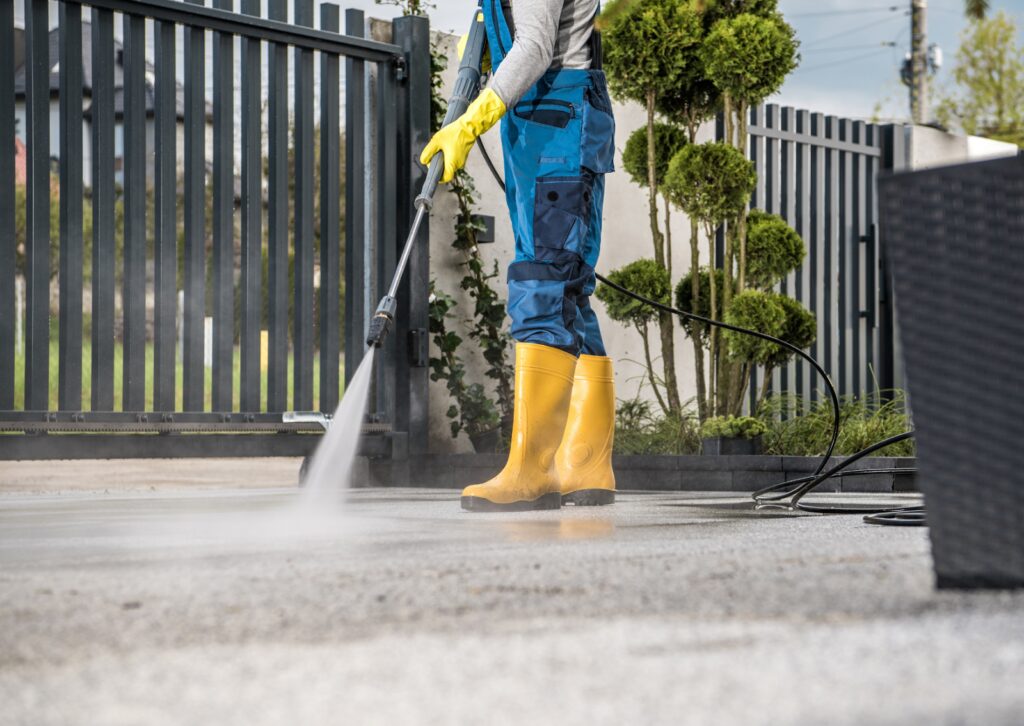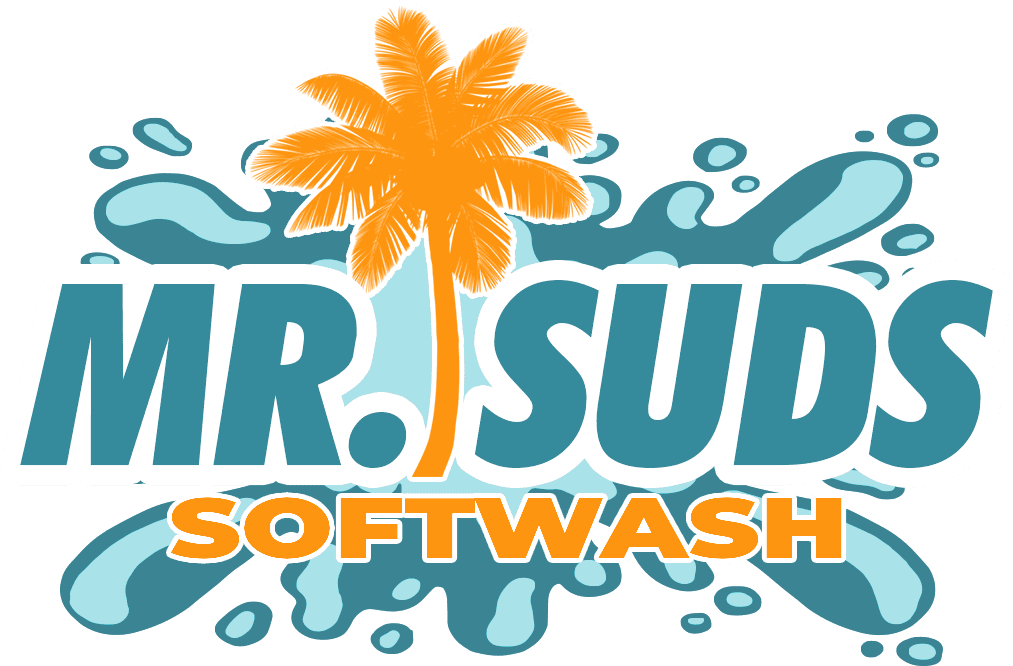We understand how important it is to maintain the beauty, safety, and longevity of your home. That starts with using the right cleaning method for your exterior surfaces. If you’ve been considering pressure washing or power washing, there’s a safer, more effective solution for delicate surfaces like roof shingles, older brickwork, and outdoor furniture. That solution is soft washing. At Mr. Suds Softwash, we’ve seen the numerous benefits of this technique firsthand.
What Is the Process of Softwashing and How Does It Work?

So, what is the process of softwashing? It begins with a carefully designed soft washing setup that includes a pump, a soft wash nozzle, and a chemical injection system. The system uses low-pressure water combined with specialized cleaning solutions, typically including a low-pressure bleach mix, to break down organic growth like algae, mold, and mildew.
These cleaning solutions are applied to the surface area and left to dwell. This dwell time allows the solution to penetrate and break down organic stains, grime, and dirt. After that, a gentle rinse with low-pressure water removes everything safely from the surface.
The soft washing system is a highly effective and eco-friendly solution that relies more on chemistry than force, reducing the risk of surface damage.
Why Is Soft Washing the Preferred Method for Cleaning Delicate Exterior Surfaces?

Unlike high-pressure water cleaning, soft washing minimizes wear and tear. Surfaces like roof shingles, asphalt roofs, vinyl siding, and older brickwork can easily suffer granular loss or crack under high pressure. Soft washing’s low-pressure washing technique avoids that.
It’s also the preferred method because it cleans deeper and lasts longer. Instead of blasting surface mold or algae, soft washing kills the primary agent causing stains. That leads to a cleaner surface and longer-lasting results.
How Does Soft Washing Compare to Pressure Washing?

Both techniques aim to clean exterior surfaces, but the tools and outcomes are different. Pressure washing uses force to remove visible dirt and stains. A pressure washer pushes high-pressure water out at high speeds, great for hard surfaces like concrete, but risky for fragile ones.
Soft washing, on the other hand, uses chemistry and low pressure. It doesn’t just remove stains, it destroys the source. And with tools like the x jet and proper soft washing equipment, professionals can treat various surfaces more thoroughly and safely.
What Surfaces Are Best Cleaned Using the Soft Washing Method?

Many exterior surfaces benefit from soft washing, especially those prone to damage:
- Roof shingles and asphalt roofs
- Painted wood and older brickwork
- Outdoor furniture and fences
- Building exteriors
- Stucco and vinyl siding
These delicate surfaces require a gentle cleaning method that won’t compromise their integrity.
What Types of Cleaning Solutions Are Used in Soft Washing?

The heart of the system lies in the specialized cleaning solutions. A blend of bleach, surfactants, and water make up the mix. Low-pressure bleach helps remove organic growth, while detergents cling to vertical surfaces to improve effectiveness.
These solutions are designed to be eco-friendly, especially when used as directed by the manufacturer’s instructions. The goal is to sanitize, not just clean.
How Does Soft Washing Effectively Remove Dirt, Grime, Mold, and Algae?

The key is dwell time and the right cleaning process. Once the cleaning solutions are applied, they begin to break down the bonds of mold, mildew, algae, and dirt on contact.
Once broken down, a rinse of low-pressure water gently clears away the debris without damaging the surface. This is far more effective than simply spraying with pressurized water, which may leave behind spores or embedded stains.
What Are the Long-Term Benefits of Soft Washing for Property Owners?

Regular soft washing provides long-term benefits that go beyond appearance. It protects your investment. Clean roofs and walls prevent organic growth, which can deteriorate materials over time. You avoid costly repairs, improve curb appeal, and protect your health by eliminating allergens.
Companies like Mr. Suds Softwash understand that a clean home isn’t just about looks, it’s about value and well-being.
Is Soft Washing an Eco-Friendly Cleaning Method?

Yes. Because low-pressure water is used, the overall water consumption is lower than high-pressure options. Also, the detergent-assisted washing relies on eco-friendly products.
Soft washing protects nearby potted plants and the surrounding area, especially when professionals use proper containment practices.
How Important Is It to Follow the Manufacturer’s Instructions When Soft Washing?

Extremely important. Using soft washing equipment incorrectly can damage surfaces or harm plants and animals. Following the manufacturer’s instructions ensures the chemicals are mixed at safe ratios and that the system is used effectively.
Wearing safety gear like protective clothing, gloves, and masks is essential, especially when handling bleach-based products.
What Tools and Equipment Are Used in a Professional Soft Washing Setup?

Professionals rely on purpose-built equipment like:
- A dedicated pump system
- Long-range soft wash nozzles
- Downstream injectors like the X Jet
- Metering valves for accurate dilution
This soft washing setup allows for precision application of cleaning solutions on both large and small surface areas.
Can I Do It Myself or Should I Hire Professionals for Softwashing Services?

While DIY options exist, hiring professionals is always safer. Professionals understand how to treat different surfaces, avoid overspray on potted plants, and use proper PPE. They’ll ensure windows are tightly closed and the surrounding landscaping is protected.
When hiring services like Mr. Suds Softwash, you’re trusting experts who prioritize your property’s well-being.
What Should You Do Before and After a Soft Washing Job?

Before the cleaning begins:
- Ensure all windows and doors are tightly closed
- Move or cover outdoor furniture
- Protect or move potted plants
- Confirm surrounding areas are shielded
Afterward:
- Rinse down nearby surfaces
- Check for missed spots
- Allow surfaces to dry fully
With proper preparation, your home will stay cleaner for longer and resist the return of mold, mildew, and algae.
Ready to Experience the Soft Washing Difference?

If your home’s exterior surfaces are stained with mold, dirt, or grime, it’s time for a solution that works. Don’t risk damage with traditional pressure washing. Instead, trust the safer and more effective results of softwashing services.
Contact Mr. Suds Softwash today for a free estimate. Our team knows how to protect your property and deliver spotless results using professional soft washing equipment and eco-friendly cleaning solutions. You’ll enjoy the long-term benefits of a cleaner, safer, and more beautiful home.
Final Thoughts
We believe your home deserves to look its best, and stay that way. Through safe, effective, and eco-friendly softwashing services, you can restore the look of your property without the risks of high-pressure methods. Whether it’s roof shingles, building exteriors, or outdoor furniture, soft washing is the smart choice for protecting your home and everything around it.
Frequently Asked Questions:
1. What is the process of softwashing?
Softwashing involves applying low-pressure water combined with specialized cleaning solutions to break down and remove organic growth like mold, algae, and dirt from exterior surfaces. The process is followed by a gentle rinse, leaving the surface clean without causing damage.
2. Is soft washing better than pressure washing for delicate surfaces?
Yes. Soft washing uses a low-pressure washing technique that is safe for delicate surfaces like roof shingles, older brickwork, and outdoor furniture, avoiding the risk of granular loss or cracking that high-pressure water can cause.
3. Can soft washing be used on all exterior surfaces?
While soft washing is ideal for many exterior surfaces, including asphalt roofs, siding, and fences, some hard surfaces may still benefit from pressure washing. A professional can help determine the best cleaning method for each surface area.
4. What kind of cleaning solutions are used in soft washing?
Soft washing systems use detergent-assisted washing solutions, often containing low-pressure bleach, surfactants, and water. These eco-friendly chemicals are designed to kill organic growth without harming your surrounding area.
5. Does soft washing actually remove mold, algae, and mildew?
Yes. The cleaning solutions used in softwashing services are designed to eliminate mold, algae, and mildew at the root, unlike pressure washing, which may only remove surface buildup temporarily.
6. What are the long-term benefits of soft washing?
Soft washing offers long-term benefits by protecting your property from premature wear, maintaining curb appeal, reducing allergens, and preventing costly repairs caused by unchecked organic growth.
7. Is soft washing safe for the environment?
Absolutely. When done correctly with eco-friendly products and adherence to manufacturer’s instructions, soft washing is a safe, water-efficient alternative to traditional power washing methods.
8. Do I need special gear to perform soft washing myself?
Yes. You’ll need proper soft washing equipment, safety gear like protective clothing, and knowledge of chemicals and dilution ratios. That’s why hiring professionals like Mr. Suds Softwash is highly recommended.
9. What tools are used in a professional soft washing setup?
A standard soft washing setup includes a pump, x-jet, soft wash nozzle, and chemical injector for applying cleaning solutions at the correct ratio and pressure.
10. How should I prepare my home before a soft washing service?
Before soft washing, ensure all doors and windows are tightly closed, move or cover potted plants and outdoor furniture, and clear the surrounding area. This protects your property and helps achieve a more thorough cleaning.

